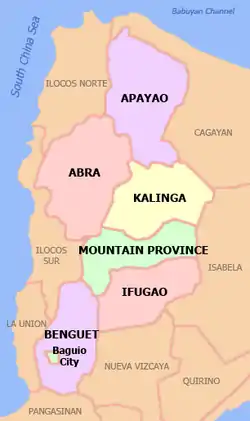Bontoc, Mountain Province
Bontoc, officially the Municipality of Bontoc (Ilocano: Ili ti Bontoc; Tagalog: Bayan ng Bontoc), is a 2nd class municipality and capital of the province of Mountain Province, Philippines. According to the 2015 census, it has a population of 24,643 people. [3]
Bontoc | |
|---|---|
| Municipality of Bontoc | |
.jpg.webp) | |
 Seal | |
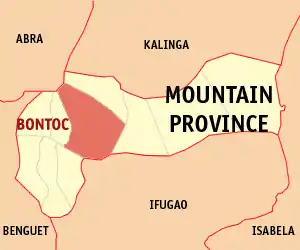 Map of Mountain Province with Bontoc highlighted | |
OpenStreetMap 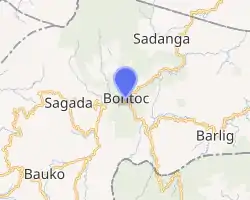
| |
.svg.png.webp) Bontoc Location within the Philippines | |
| Coordinates: 17°05′14″N 120°58′32″E | |
| Country | |
| Region | Cordillera Administrative Region (CAR) |
| Province | Mountain Province |
| District | Lone District |
| Founded | 1908 |
| Barangays | 16 (see Barangays) |
| Government | |
| • Type | Sangguniang Bayan |
| • Mayor | Franklin C. Odsey |
| • Vice Mayor | Eusebio S. Kabluyen |
| • Representative | Maximo Y. Dalog Jr. |
| • Electorate | 16,040 voters (2019) |
| Area | |
| • Total | 396.10 km2 (152.94 sq mi) |
| Elevation | 1,173 m (3,848 ft) |
| Population | |
| • Total | 24,643 |
| • Density | 62/km2 (160/sq mi) |
| • Households | 6,307 |
| Economy | |
| • Income class | 2nd municipal income class |
| • Poverty incidence | 15.43% (2015)[4] |
| • Revenue | ₱123,441,548.36 (2016) |
| Time zone | UTC+8 (PST) |
| ZIP code | 2616 |
| PSGC | |
| IDD : area code | +63 (0)74 |
| Climate type | tropical rainforest climate |
| Native languages | Balangao Bontoc Ilocano Tagalog |
| Website | bontoc |
Bontoc is the historical capital of the entire Cordillera region since the inception of governance in the Cordillera. The municipality celebrates the annual Lang-ay Festival.[5]
Bontoc is home to the Bontoc tribe, a feared war-like group of indigenous people who actively indulged in tribal wars with its neighbors until the 1930s. Every Bontoc male had to undergo a rite of passage into manhood, which may include headhunting, where the male has to journey (sometimes with companions) and hunt for a human head. The Bontoc also used the jaw of the hunted head as a handle for gongs, and as late as the early 1990s, evidence of this practice can be seen from one of the gongs in Pakistan, Bontoc. The town also hosts the UNESCO tentatively-listed Alab petroglyphs.
History
Samuel E. Kane, the American supervisor and then Governor, established the capital here after the Philippine Commission passed the Mountain Province Act in 1908,[6] building a provincial building, hospital, doctor's office, nurse's home, a school, and provincial prison.[7]:281–284 He also built the Tagudin-Bontoc trail, which by 1926, could accommodate a small car.[7]:329
Barangays
Bontoc is politically subdivided into 16 barangays.
- Alab Proper
- Alab Oriente
- Balili
- Bay-yo
- Bontoc Ili
- Caluttit
- Can-eo
- Dalican
- Gonogon
- Guinaang
- Mainit
- Maligcong
- Samoki
- Talubin
- Tocucan
- Poblacion (Bontoc)
Climate
| Climate data for Bontoc, Mountain Province | |||||||||||||
|---|---|---|---|---|---|---|---|---|---|---|---|---|---|
| Month | Jan | Feb | Mar | Apr | May | Jun | Jul | Aug | Sep | Oct | Nov | Dec | Year |
| Average high °C (°F) | 23 (73) |
24 (75) |
25 (77) |
27 (81) |
27 (81) |
26 (79) |
25 (77) |
25 (77) |
25 (77) |
25 (77) |
24 (75) |
23 (73) |
25 (77) |
| Average low °C (°F) | 16 (61) |
16 (61) |
17 (63) |
19 (66) |
20 (68) |
21 (70) |
21 (70) |
21 (70) |
20 (68) |
19 (66) |
18 (64) |
17 (63) |
19 (66) |
| Average precipitation mm (inches) | 35 (1.4) |
46 (1.8) |
63 (2.5) |
117 (4.6) |
402 (15.8) |
400 (15.7) |
441 (17.4) |
471 (18.5) |
440 (17.3) |
258 (10.2) |
94 (3.7) |
68 (2.7) |
2,835 (111.6) |
| Average rainy days | 9.9 | 19.5 | 13.9 | 18.9 | 26.0 | 27.3 | 28.9 | 28.5 | 26.1 | 19.7 | 14.5 | 12.8 | 246 |
| Source: Meteoblue [8] | |||||||||||||
Demographics
|
| |||||||||||||||||||||||||||||||||||||||||||||
| Source: Philippine Statistics Authority [3] [9] [10][11] | ||||||||||||||||||||||||||||||||||||||||||||||
Most inhabitants speak the Bontoc language, with other major languages being Kankana-ey and Ilocano. Minor languages spoken include Tagalog, Pangasinan, Cuyonon and Butuanon.[12]
Economy
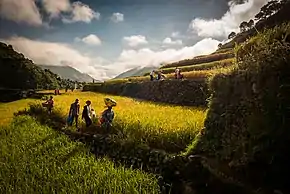
_(18246004349).jpg.webp)
The local economy depends largely on small trades and agriculture. This capital town's biggest economic potential is tourism with its smaller rice terraces in Barangay Bay-yo, Maligcong and other areas.[13]
Culture
The highland town of Bontoc is home to two National Cultural Treasures of the Philippines. These are the Stone Agricultural Calendar of Bontoc and Petroglyphs of Alab.[14]
The Alab petroglyphs are ancient figures carved on mountain walls by the prehistoric people of Bontoc.[15] The petroglyphs are the most important ancient rock art carvings in the Cordilleras and the second oldest in the entire country, second only to the Angono petroglyphs of Rizal. Due to its high significance, it was submitted by the National Commission for Culture and the Arts of the Philippines to the UNESCO Tentative List of Heritage Sites in 2006, pending its inclusion in the World Heritage List along with the Singanapan charcoal-drawn petrographs of southern Palawan, Angono petroglyphs of Rizal province, charcoal-drawn Peñablanca petrographs of Cagayan, and the Anda red hermatite print petrographs of Bohol.
The Bontoc people have their own indigenous religion that has been preserved for centuries. They believe in a unique pantheon of deities, of which the supreme god is the cultural hero, Lumawig, son of Kabunian. There are many sacred sites associated with Lumawig and a variety of Bontoc deities. Oral tradition tells that Lumawig instilled five great lessons to the Bontoc people, namely: (1) a man must not steal; (2) one should not gossip; (3) men and women must not commit adultery; (4) one must be temperate in eating and in drinking alcoholic drinks; and (5) all people must live simple and industrious lives.[16]
Indigenous Bontok Religion
Immortals
- Intutungcho (Kabunian): the supreme deity living above;[17] also referred to as Kabunian;[18] father of Lumawig and two other sons[19]
- Lumawig: also referred as the supreme deity and the second son of Kabunian; an epic hero who taught the Bontoc their five core values for an egalitarian society[19]
- First Son of Kabunian[19]
- Third Son of Kabunian[19]
- Chal-chal: the god of the sun whose son's head was cut off by Kabigat;[20] aided the god Lumawig in finding a spouse
- Kabigat: the goddess of the moon who cut of the head of Chal-chal's son; her action is the origin of headhunting[20]
- Son of Chal-chal: his head was cut off by Kabigat; revived by Chal-chal, who bear no ill will against Kabigat[20]
- Ob-Obanan: a deity whose white hair is inhabited by insects, ants, centipedes, and all the vermins that bother mankind; punished a man for his rudeness by giving him a basket filled with all the insects and reptiles in the world[21]
- Chacha’: the god of warriors[22]
- Ked-Yem: the god of blacksmiths who cut off the heads of the two sons of Chacha’ because they were destroying his work; was later challenged by Chacha’, which eventually led into a pechen pact to stop the fighting[22]
- Two Sons of Chacha’: beheaded by Ked-Yem, because they were destroying his work[22]
Mortals
- Fucan: younger of the two girls met by Lumawig in Lanao; married to Lumawig; later adopted the name Cayapon; died after dancing in a taboo way, which led to death being the norm among mortals[19]
- Two Sons of Cayapon: the two children of Lumawig and Fucan; helped the people of Caneo, who afterwards killed by the two brothers[19]
- Batanga: father of the two girls met by Lumawig in Lanao[19]
Education
Secondary education
| Institution | Location |
|---|---|
| ALBAGO National High School | Balili |
| Dalican National High School | Dalican |
| Guina-ang National High School | Guina-ang |
| Mountain Province General Comprehensive High School | Poblacion |
| Saint Vincent School | Poblacion |
| Talubin National High School | Talubin |
| Tocucan National High School | Tocucan |
Tertiary education
Mountain Province State Polytechnic College is the first tertiary institution in the municipality that offers various undergraduate and graduate courses.
XiJen College of Mountain Province is the only private tertiary institution that also offers technical-vocational courses.
References
- Municipality of Bontoc | (DILG)
- "Province: Mountain Province". PSGC Interactive. Quezon City, Philippines: Philippine Statistics Authority. Retrieved 12 November 2016.
- Census of Population (2015). "Cordillera Administrative Region (CAR)". Total Population by Province, City, Municipality and Barangay. PSA. Retrieved 20 June 2016.
- "PSA releases the 2015 Municipal and City Level Poverty Estimates". Quezon City, Philippines. Retrieved 12 October 2019.
- Malingan, Jamie Joie (12 April 2018). "Feature: Lang-Ay Festival: Celebrating a Culture of Sharing". Philippine Information Agency. Archived from the original on 22 February 2019. Retrieved 22 February 2019.
- "Act No. 1876". PhilippineLaw.info. 18 August 1908. Archived from the original on 2014-10-15. Retrieved 22 October 2014.
- Kane, S.E., 1933, Thirty Years with the Philippine Head-Hunters, New York: Grosset & Dunlap
- "Bontoc: Average Temperatures and Rainfall". Meteoblue. Retrieved 8 March 2020.
- Census of Population and Housing (2010). "Cordillera Administrative Region (CAR)". Total Population by Province, City, Municipality and Barangay. NSO. Retrieved 29 June 2016.
- Censuses of Population (1903–2007). "Cordillera Administrative Region (CAR)". Table 1. Population Enumerated in Various Censuses by Province/Highly Urbanized City: 1903 to 2007. NSO.
- "Province of Mountain Province". Municipality Population Data. Local Water Utilities Administration Research Division. Retrieved 17 December 2016.
- "Annual Report; Local Government of Bontoc; CY 2011" (PDF). Local Government of Bontoc. 2011. Retrieved 22 February 2019.
- "Mt. Province Travel Information". Asia Travel. Archived from the original on 7 May 2001. Retrieved 22 February 2019.
- "Presidential Decree No. 260, s. 1973;". Official Gazette of the Republic of the Philippines. Archived from the original on 19 June 2018. Retrieved 22 February 2019.
- "Annual Report 2010; National Museum" (PDF). Manila, Philippines: National Museum of the Philippines. 2010. Retrieved 22 February 2019.
- https://www.aswangproject.com/the-bontoc-legend-of-lumawig-culture-hero/
- Bacwaden, J. O. C. (1997). Philippine Studies: Vol. 45, No. 1: The Lumawig Bontoc Myths. Ateneo de Manila University.
- Beyer, H. O. (1913). Origin Myths Among the Mountain Peoples of the Philippines. Philippine Journal of Science, 85-117.
- Cawed, C. (1972). The Culture of the Bontoc Igorot. MCS Enterprises.
- Jenks, A. (1905). The Bontoc Igorot. Manila: Bureau of Printing.
- Almendral, E. C. (1972). Talubin Folklore, Bontoc, Mountain Province. Baguio City: Lyceum of Baguio.
- Cawed, C. (1972). The Culture of the Bontoc Igorot. Manila: MCS Enterprises .
External links
| Wikimedia Commons has media related to Bontoc, Mountain Province. |


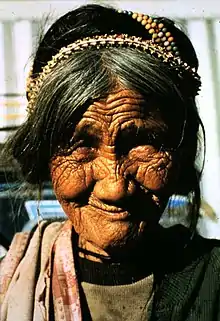
_(14579727919).jpg.webp)
